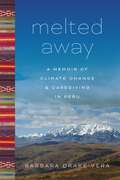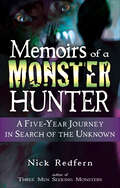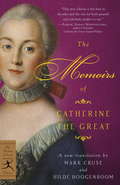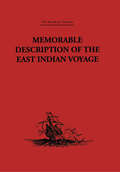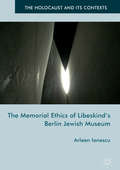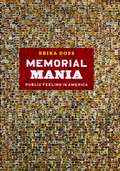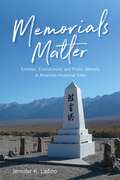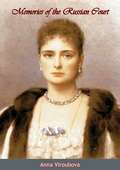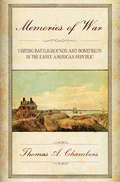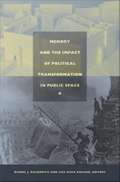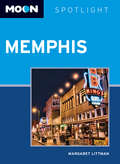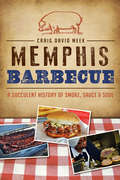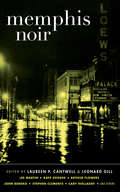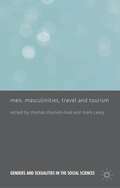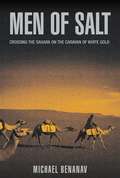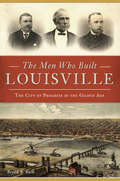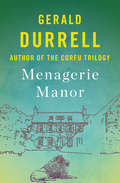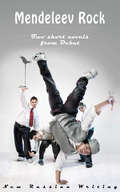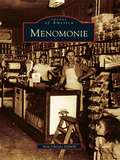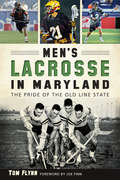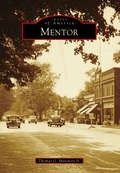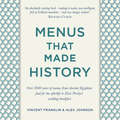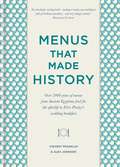- Table View
- List View
Melted Away: A Memoir of Climate Change and Caregiving in Peru
by Barbara Drake-VeraA prolific poet as a child, Barbara Drake-Vera loved writing almost as much as she adored her father, a moody postal employee with an elaborate comb-over and a fondness for Mahler. But when her successes sparked his rage, Barbara silenced her voice for years, terrified even to see her name in print. By age forty-nine, she was a professional journalist living in Peru and collaborating with her husband, a Peruvian-born photographer, to report on melting glaciers in the Andes, far from the reach of her father. Melted Away recounts what happens after her father is diagnosed with advancing Alzheimer’s and Barbara takes him into her home in Lima, beginning a process of self-discovery that uncovers a path toward personal and family healing. A diverse group of allies support her on this quest: a trio of caregiving women from the provinces, who serve as home-health aides; a mischievous, Cervantes-quoting, nonagenarian suitor; and a stubborn alpaca herder who lives beneath a long-worshipped, life-sustaining Andean glacier now melting from rapid climate change.Candid, poignant, and deeply researched, Melted Away is the true story of how a writer at midlife reclaims her agency, and an ardent plea to care for the planet by embracing collectivism and mutual aid.
Memoirs of a Monster Hunter: A Five-Year Journey in Search of the Unknown
by Nick RedfernThe British paranormal investigator recounts his five-year journey through America in pursuit of the monstrous unknown in this memoir.For centuries, people across the world have had a fascination with monsters and strange creatures. They marvel at the tales and legends of the Bigfoot of the Pacific Northwest; of the Abominable Snowman of the Himalayas; of the infamous and diabolical Moth-Man of West Virginia; of fire-breathing dragons; and of those dark denizens of the deep: lake monsters and sea serpents. But do such creatures really exist? Can it be true that our planet is home to fantastic beasts that lurk deep within its forests and waters? Memoirs of a Monster Hunter proves the answer is a resounding yes!In this follow-up to his wildly successful Three Men Chasing Monsters, paranormal investigator and author Nick Redfern chronicles his surreal road-trip through the United States and beyond in search of all-things monstrous. His strange adventures lasted five years and saw him doggedly pursuing a menagerie of creatures, including gargoyles, giant birds, and what some believe are living dinosaurs. Follow Redfern as he:Explores the El Yunque rainforest of Puerto Rico in search of the terrifying Chupacabras: a razor-clawed, glowing-eyed beast that is part giant bat and part vampireSeeks out the Goat Man: a menacing creature that evokes imagery of both demons and the fabled cloven-hoofed Centaurs of ancient mythology, and is said to inhabit the forests of East TexasChases after what many people believe are real-life, flesh-and-blood werewolves that surface from hidden lairs and prowl the countryside when the Moon is fullPart X-Files, part Crocodile Hunter with a mix of Jurassic Park and Fear and Loathing in Las Vegas, Memoirs of a Monster Hunter takes you on a roller-coaster ride into the unknown. Read personal accounts of the monsters that inhabit your wildest imagination and your worst nightmares. The creatures you were told couldn’t possibly exist, really do.Praise for Memoirs of a Monster Hunter“This is one of the best books I’ve read in years. Redfern sweeps you away on his personal adventure. Around the world, from romance, to ghastly beasts, to the cosmos, Redfern has candidly shared the wonders of his young life.” —Joshua P. Warren, author of Pet Ghosts and How to Hunt Ghosts
The Memoirs of Catherine the Great (Modern Library Classics)
by Catherine The Great Hilde Hoogenboom Markus CruseEmpress Catherine II brought Europe to Russia, and Russia to Europe, during her long and eventful reign (1762--96). She fostered the culture of the Enlightenment and greatly expanded the immense empire created by Czar Ivan the Terrible, shifting the balance of power in Europe eastward. Famous for her will to power and for her dozen lovers, Catherine was also a prolific and gifted writer. Fluent in French, Russian, and German, Catherine published political theory, journalism, comedies, operas, and history, while writing thousands of letters as she corresponded with Voltaire and other public figures. The Memoirs of Catherine the Great provides an unparalleled window into eighteenth-century Russia and the mind of an absolute ruler. With insight, humor, and candor, Catherine presents her eyewitness account of history, from her whirlwind entry into the Russian court in 1744 at age fourteen as the intended bride of Empress Elizabeth I's nephew, the eccentric drunkard and future Peter III, to her unhappy marriage; from her two children, several miscarriages, and her and Peter's numerous affairs to the political maneuvering that enabled Catherine to seize the throne from him in 1762. Catherine's eye for telling details makes for compelling reading as she describes the dramatic fall and rise of her political fortunes.This definitive new translation from the French is scrupulously faithful to her words and is the first for which translators have consulted original manuscripts written in Catherine's own hand. It is an indispensable work for anyone interested in Catherine the Great, Russian history, or the eighteenth century.From the Hardcover edition.
Memorable Description of the East Indian Voyage: 1618-25
by Willem Ysbrantsz BontekoeFirst published in 1929. 'Fire and shipwreck, fights ashore and afloat, the pitting of ceaseless patience and resource against fate, these things make one understand why the book, famous in its original tongue, has but to be savoured in translation to gain an equal popularity.' Manchester Guardian Bontekoe's East Indian Voyage was one of the most popular books in which the Dutch seventeenth century public delighted and it continued to be reprinted throughout the seventeenth and eighteenth centuries. As well as providing an illuminating insight into the machinations of the Merchants and Directors of the East India Company and the often troubled waters of international trade and diplomacy, the account is a very personal one: of a human being battling against elemental forces, at tremendous odds, tenaciously holding on to life and coming through in the end.
The Memorial Ethics of Libeskind's Berlin Jewish Museum
by Arleen IonescuThis book is a detailed critical study of Libeskind's Berlin Jewish Museum in its historical, architectural and philosophical context. Emphasizing how the Holocaust changed our perception of history, memory, witnessing and representation, it develops the notion of 'memorial ethics' to explore the Museum's difference from more conventional post-World War Two commemorative sites. The main focus is on the Museum as an experience of the materiality of trauma which engages the visitor in a performative duty to remember. Arleen Ionescu builds on Levinas's idea of 'ethics as optics' to show how Libeskind's Museum becomes a testimony to the unpresentable Other. Ionescu also extends the Museum's experiential dimension by proposing her own subjective walk through Libeskind's space reimagined as a 'literary museum'. Featuring reflections on texts by Beckett, Celan, Derrida, Kafka, Blanchot, Wiesel and Selma Meerbaum-Eisinger (Celan's cousin), this virtual tour concludes with a brief account of Libeskind's analogous 'healing project' for Ground Zero.
Memorial Mania: Public Feeling in America
by Erika DossIn the past few decades, thousands of new memorials to executed witches, victims of terrorism, and dead astronauts, along with those that pay tribute to civil rights, organ donors, and the end of Communism have dotted the American landscape. Equally ubiquitous, though until now less the subject of serious inquiry, are temporary memorials: spontaneous offerings of flowers and candles that materialize at sites of tragic and traumatic death. In Memorial Mania, Erika Doss argues that these memorials underscore our obsession with issues of memory and history, and the urgent desire to express—and claim—those issues in visibly public contexts. Doss shows how this desire to memorialize the past disposes itself to individual anniversaries and personal grievances, to stories of tragedy and trauma, and to the social and political agendas of diverse numbers of Americans. By offering a framework for understanding these sites, Doss engages the larger issues behind our culture of commemoration. Driven by heated struggles over identity and the politics of representation, Memorial Mania is a testament to the fevered pitch of public feelings in America today.
Memorials Matter: Emotion, Environment, and Public Memory at American Historical Sites
by Jennifer K. LadinoJennifer Ladino investigates the natural and physical environments of seven diverse National Park Service (NPS) sites in the American West and how they influence emotions about historical conflict and national identity. Chapters center around the region's diverse inhabitants and the variously traumatic histories these groups endured--histories of oppression, exploitation, incarceration, slavery, and genocide.
Memories of the Russian Court
by Anna ViroubovaThese are the memoirs of Anna Alexandrovna Vyrubova, a close friend of the last Imperial family of Russia, and aim to set right the many false and invented stories written about Nicholas II and Alexandra and Anna's relationship with them.The book provides rare descriptions of the home life of the Tsar and his family, vividly portrays her perils in prison and her narrow escape from execution, and recollects the enormous hardship she endured avoiding the Bolsheviks before escaping to Finland in December 1920.A truly fascinating read.
Memories of War: Visiting Battlegrounds and Bonefields in the Early American Republic
by Thomas A. ChambersEven in the midst of the Civil War, its battlefields were being dedicated as hallowed ground. Today, those sites are among the most visited places in the United States. In contrast, the battlegrounds of the Revolutionary War had seemingly been forgotten in the aftermath of the conflict in which the nation forged its independence. Decades after the signing of the Constitution, the battlefields of Yorktown, Saratoga, Fort Moultrie, Ticonderoga, Guilford Courthouse, Kings Mountain, and Cowpens, among others, were unmarked except for crumbling forts and overgrown ramparts. Not until the late 1820s did Americans begin to recognize the importance of these places. In Memories of War, Thomas A. Chambers recounts America's rediscovery of its early national history through the rise of battlefield tourism in the first half of the nineteenth century. Travelers in this period, Chambers finds, wanted more than recitations of regimental movements when they visited battlefields; they desired experiences that evoked strong emotions and leant meaning to the bleached bones and decaying fortifications of a past age. Chambers traces this impulse through efforts to commemorate Braddock's Field and Ticonderoga, the cultivated landscapes masking the violent past of the Hudson River valley, the overgrown ramparts of Southern war sites, and the scenic vistas at War of 1812 battlefields along the Niagara River. Describing a progression from neglect to the Romantic embrace of the landscape and then to ritualized remembrance, Chambers brings his narrative up to the beginning of the Civil War, during and after which the memorialization of such sites became routine, assuming significant political and cultural power in the American imagination.
Memory and the Impact of Political Transformation in Public Space
by Daniel J. Walkowitz Lisa Maya KnauerMemory and the Impact of Political Transformation in Public Space explores the effects of major upheavals--wars, decolonization, and other social and economic changes--on the ways in which public histories are presented around the world. Examining issues related to public memory in twelve countries, the histories collected here cut across political, cultural, and geographic divisions. At the same time, by revealing recurring themes and concerns, they show how basic issues of history and memory transcend specific sites and moments in time. A number of the essays look at contests over public memory following two major political transformations: the wave of liberation from colonial rule in much of Africa, Asia, and Central and South America during the second half of the twentieth century and the reorganization of Eastern Europe and the former Soviet bloc beginning in the late 1980s. This collection expands the scope of what is considered public history by pointing to silences and absences that are as telling as museums and memorials. Contributors remind us that for every monument that is erected, others--including one celebrating Sri Lanka's independence and another honoring the Unknown Russian Soldier of World War II--remain on the drawing board. While some sites seem woefully underserved by a lack of public memorials--as do post-Pinochet Chile and post-civil war El Salvador--others run the risk of diluting meaning through overexposure, as may be happening with Israel's Masada. Essayists examine public history as it is conveyed not only in marble and stone but also through cityscapes and performances such as popular songs and parades. Contributors James Carter John Czaplicka Kanishka Goonewardena Lisa Maya Knauer Anna Krylova Teresa Meade Bill Nasson Mary Nolan Cynthia Paces Andrew Ross Daniel Seltz T. M. Scruggs Irina Carlota Silber Daniel J. Walkowitz Yael Zerubavel
Memory, Migration and Travel (Contemporary Geographies of Leisure, Tourism and Mobility)
by Sabine MarschallMigration and forcible displacement are growing and impactful dynamics of the current global age. These processes generate mobility flows, travel patterns and touristic behaviour driven by personal and collective memories. The chapters in this book highlight the importance of travel and tourism for enabling such memories and memory-based identity practices to unfold. This book investigates how diasporic communities, transnational migrants, refugees and the internally displaced recreate home in their host place of residence through material culture, performativity and social relations; and how involuntary tangible and intangible stimuli evoke memories of home. It explores an array of diverse geographical contexts, balancing ethnographic vignettes of contemporary migrant societies with archival research providing historical accounts that reach back more than a century. Memory, Migration and Travel makes an original contribution by linking the emergent field of memory studies to the disciplines of tourism and migration/diaspora studies, and will be of interest to students and researchers in the fields of tourism, geography, migration/diaspora studies, anthropology and sociology.
Memphis
by Margaret Littman'Moon Spotlight Memphis' is an 80-page compact guide covering the ins and outs of the Home of the Blues. Tennessee resident Margaret Littman offers her firsthand advice on must-see attractions, as well as maps with sightseeing highlights, so you can make the most of your time. This lightweight guide is packed with recommendations on entertainment, shopping, recreations, accommodations, food, and transportation, making navigating this musical mecca uncomplicated and enjoyable. This Spotlight guidebook is excerpted from 'Moon Tennessee. '
Memphis Barbecue: A Succulent History of Smoke, Sauce & Soul (American Palate)
by Craig David MeekThe lifelong Memphian and food blogger “examines the history of the city one plate of barbecue at a time” (High Ground).The city’s blues and soul music have lifted spirits, while barbecue has been a serious business ever since pork first entered the culinary landscape of Memphis with Spanish explorer Hernando de Soto, who brought the New World its first herd of pigs. Succulent pulled pork and ribs have become part of the fabric of life in Bluff City, and today they are cooked up in kitchens ranging from the internationally acclaimed, like Corky’s, to the humblest of roadside dives. Told through the history of its barbecue is the story of the city of Memphis, from legendary joints like Leonard’s Barbecue, where Elvis Presley hosted private parties, to lesser-known places like William’s Bar-B-Q in the West Memphis, Arkansas neighborhood where wild, late-night blues juke joints served as a red-light district across the river from Beale Street in the 1950s and ’60s. Sink your teeth into this rich history chock-full of interviews and insights from the city’s finest pitmasters and ’cue gurus who continue the long tradition of creating art with meat and flame.“There are some amazing moments in Memphis Barbecue—like Jim Neely speaking quite frankly about his TV celebrity nephew Pat Neely and John Willingham’s widow remembering the barbecue legend’s last day.” —Memphis Flyer
Memphis Noir (Akashic Noir)
by Leonard Gill Laureen Cantwell"A remarkable picture of contemporary Memphis emerges in this Akashic noir volume...Something for everyone."--Publishers Weekly"Voodoo, ghosts, guns, hatred, jealousy and greed play their part here. There is no place for weakness here."--Journey of a BooksellerAkashic Books continues its groundbreaking series of original noir anthologies, launched in 2004 with Brooklyn Noir. Each story is set in a distinct neighborhood or location within the city of the book.Featuring brand-new stories by: Richard J. Alley, David Wesley Williams, Dwight Fryer, Jamey Hatley, Adam Shaw, Penny Register-Shaw, Kaye George, Arthur Flowers, Suzanne Berube Rorhus, Ehi Ike, Lee Martin, Stephen Clements, Cary Holladay, John Bensko, Sheree Renée Thomas, and Troy L. Wiggins.From the introduction by Laureen P. Cantwell & Leonard Gill:"A city equal parts darkness and hope. A scarred city. An often violent one. But a resilient city too.That's our Memphis.Like many cities, we have a namesake--in Egypt, Men-nefer became Menfe became Memphis, enduring and beautiful, on the banks of the Nile. Centuries later, another continent, another people, another river: Memphis, Tennessee, the soul of the Mississippi Delta, was formed. We are a place born of history, inhabited as much by memory as by the living--the past and present inextricably and inescapably linked....Memphis is marvels and misfits--two-faced and unabashedly so. We are Memphis, and this is our noir."
Men, Masculinities, Travel and Tourism
by Thomas Thurnell-Read Mark CaseyMen, Masculinities, Travel and Tourism draws together established and emerging academics that have a key interest in men, masculinity, travel and tourism. Through the chapters collected in this volume the reader will be exposed to cutting edge research and writing that offer global and local perspectives within these fields.
Men of Salt: Crossing the Sahara on the Caravan of White Gold
by Michael BenanavIn fact, there was no road at all, just an endless stretch of desert sand called "The Land of Terror" by the nomads who cross it, and described by author Michael Benanav with humor and startling insight in this compelling narrative. Benanav joined what is known as the Caravan of White Gold -- so-called because the salt was once literally worth its weight in gold -- on its mission into the deadly heart of the Sahara to haul back gleaming slabs of solid salt for sale at market. He'd been seized by the idea after coming across an article about the dying days of the caravan: "It was that feeling known by those of us who don't so much take journeys as are taken by journeys: hearing the call of a particular place for a particular purpose that will not be denied. It was the kind of trip I was born to take." Following his amused guide, Walid, Benanav lived for weeks among the camel drivers as they traveled eighteen hours a day for nearly a thousand miles without a map or landmark in sight, through sandstorms and searing heat. Along the way, he learned how to care for and ride camels, became a medic to injured salt miners, and grappled with the dilemmas of cultural extinction created by the ever-widening impact of globalization. MEN OF SALT is a revelation, introducing an important new voice to the tradition of travel literature.
The Men Who Built Louisville: The City Of Progress In The Gilded Age
by Bryan S. BushFrom 1870 to 1900, Louisville became a larger part of the American Industrial Revolution. The expansion of railroads was a key factor to becoming a center for industry, trade and commerce. Paul Jones Jr. helped the city become a world leader in bourbon production, and Louisville was the largest tobacco manufacturer due to successful brokers like Andrew Graham. John Leather's jean cloth facility was among the most productive in the world. The largest box factory also resided in the city, and Louisville became the banking capital of the South. Author Bryan S. Bush details those behind the massive industry in the City of Progress.
Menagerie Manor: A Zoo In My Luggage, The Whispering Land, And Menagerie Manor (The Zoo Memoirs #3)
by Gerald DurrellThe beloved naturist and author of My Family and Other Animals shares the pleasures and pitfalls of opening a zoo on the English Channel Island of Jersey. Spurred by his passion for animals and a lifelong dream, in the spring of 1959 Gerald Durrell opened the Jersey Zoo—now known as the Durrell Wildlife Park—on the grounds of an old manor house. The menagerie provided a safe habitat for rare and endangered species and exposed its human visitors to the wonders of nature. Dealing with escapee animals and overdrawn bank accounts, Durrell soon discovered that owning and operating a fledgling zoo was no easy task. But despite the setbacks, these charming, often hilarious stories make clear that, for Durrell, ensuring the park&’s success and helping the creatures he loved so dearly was worth any obstacle. This ebook features an illustrated biography of Gerald Durrell including rare photos from the author&’s estate.
Mend the Living: WINNER OF THE WELLCOME BOOK PRIZE 2017
by Maylis de KerangalWinner of the Wellcome Book Prize 2017.Longlisted for the Man Booker International Prize 2016. Now a major French film, REPARER LES VIVANTS/HEAL THE LIVING, directed by Katell Quillevere and starring Emmanuelle Seigner.A twenty-four-hour whirlwind of death and life.In the depths of a winter's night, the heart of Simon Limbeau is resting, readying itself for the day to come. In a few hours' time, just before six, his alarm will go off and he will venture into the freezing dawn, drive down to the beach, and go surfing with his friends. A trip he has made a hundred times and yet, today, the heart of Simon Limbeau will encounter a very different course.But for now, the black-box of his body is free to leap, swell, melt and sink, just as it has throughout the years of Simon's young life.5.50 a.m.This is his heart.And here is its story.Translated from the French by Jessica Moore
Mendeleev Rock
by Andrei Kuzechkin Pavel KostinThese two novels by Debut Prize finalists present typical provincial towns in central Russia and a gallery of modern-day types: radically minded youths, ruthless thugs, drunken intellectuals, the local elite, and failed fortune seekers. The heroes are yearning for faraway glamorous cities and trying to find their identities. They suffer through various weird misadventures, but for many readers their tales may be a survival guide. A vivid portrait of the younger generation in today's Russia: stunned by their first painful contacts with harsh reality. The authors will present the book at BEA 2011 in New York.
Menomonie
by Ann Christy DybvikHistoric Menomonie lies alongside the beautiful Red Cedar River in western Wisconsin. A town with a rich, diverse history, it grew to become home to a massive lumbering era spearheaded by four innovative pioneer men whose heritage continues to identify the city. Lumbering gave way to the establishment of respected sleigh, brick, piano, and cigar factories in the early 1900s. Throughout these eras, up until the present, inventors, artists, educators, philanthropists, and farmers all put their stamp on the town. Home to the popular Red Cedar Trail, it also is the site of the Mabel Tainter Theatre, an ornate historic building constructed to memorialize a young daughter. Dairy farms still pepper the hillsides, small businesses line Main Street, farmers still market products in the park, and Stout University leads the way in education; and always the arts abound in the nooks and valleys that comprise Menomonie."
Men's Lacrosse in Maryland: The Pride of the Old Line State (Sports)
by Tom FlynnSpring in Maryland means one thing: lacrosse. As much a part of the state as crab cakes and the Chesapeake Bay, lacrosse is king at every level, from youth rec and club to high school, college and the pros. Since the state first fielded teams in the 1870s, Marylanders have played with a unique combination of finesse, speed and passion. The "Maryland style" of play built a long line of national powerhouses at all levels. With extensive research and dozens of photographs, journalist Tom Flynn traces the long history of the sport in Maryland from its Native American roots to its first arrival in the state and on to the modern highlights. Fans will rediscover their many past champions and gain a glimpse of teams that promise to elevate the sport's status as the pride of the Old Line State.
Mentor
by Thomas G. Matowitz Jr.One of the first towns settled in the lands once known as Connecticut's Western Reserve, Mentor continues to thrive more than two centuries later. After starting out in 1797 as a sparsely populated wilderness outpost with only a handful of permanent residents, Mentor has transformed into a vibrant 21st-century city. The earliest settlers began the great task of felling trees, clearing land, and establishing farms to provide themselves with food and shelter during the area's harsh winters. Through the 19th century, Mentor's growth was slow but steady. Its citizens not only included hardworking farmers and artisans, but wealthy turn-of-the-20th-century Cleveland business leaders, a Civil War Medal of Honor recipient, and the 20th president of the United States, James A. Garfield. Once known for extensive farmland, grand country estates, interurban railroads, and some of the finest nurseries in the country, Mentor is now a diverse community with more than 50,000 residents and a strong and burgeoning local economy.
Menus that Made History: Over 2000 years of menus from Ancient Egyptian food for the afterlife to Elvis Presley's wedding breakfast
by Alex Johnson Vincent Franklin'An absolutely riveting book - reading it makes you intelligent, full of brilliant anecdotes - and very hungry indeed.' - Richard Curtis 'This brilliantly conceived and well-researched book is a source of real delight.' - Dr Annie Gray, BBC Radio 4's The Kitchen Cabinet 'Superbly written, a complete joy to read, and just about the perfect present for anyone even vaguely interested in food.' - Mark Diacono'A gastronomic delight. You can savour it a course at a time, or you may consume the whole banquet in one sitting. It's delicious either way - utterly scrumptious, in fact!' - Mike LeighThis fascinating miscellany of menus from around the world will educate as well as entertain, delighting both avid foodies and the general reader.Each menu provides an insight into its particular historical moment - from the typical food on offer in a nineteenth-century workhouse to the opulence of George IV's gargantuan coronation dinner. Some menus are linked with a specific and unforgettable event such as The Hindenburg's last flight menu or the variety of meals on offer for First, Second and Third Class passengers on board RMS Titanic, while others give an insight into sport, such as the 1963 FA Cup Final Dinner or transport and travel with the luxury lunch on board the Orient Express. Also included are literary occasions like Charles' Dickens 1868 dinner at Delmonicos in New York as well as the purely fictional and fantastical fare of Ratty's picnic in The Wind in the Willows.
Menus that Made History: Over 2000 years of menus from Ancient Egyptian food for the afterlife to Elvis Presley’s wedding breakfast
by Alex Johnson Vincent Franklin'An absolutely riveting book - reading it makes you intelligent, full of brilliant anecdotes - and very hungry indeed.' - Richard Curtis 'This brilliantly conceived and well-researched book is a source of real delight.' - Dr Annie Gray, BBC Radio 4's The Kitchen Cabinet 'Superbly written, a complete joy to read, and just about the perfect present for anyone even vaguely interested in food.' - Mark Diacono'A gastronomic delight. You can savour it a course at a time, or you may consume the whole banquet in one sitting. It's delicious either way - utterly scrumptious, in fact!' - Mike LeighThis fascinating miscellany of menus from around the world will educate as well as entertain, delighting both avid foodies and the general reader.Each menu provides an insight into its particular historical moment - from the typical food on offer in a nineteenth-century workhouse to the opulence of George IV's gargantuan coronation dinner. Some menus are linked with a specific and unforgettable event such as The Hindenburg's last flight menu or the variety of meals on offer for First, Second and Third Class passengers on board RMS Titanic, while others give an insight into sport, such as the 1963 FA Cup Final Dinner or transport and travel with the luxury lunch on board the Orient Express. Also included are literary occasions like Charles' Dickens 1868 dinner at Delmonicos in New York as well as the purely fictional and fantastical fare of Ratty's picnic in The Wind in the Willows.
